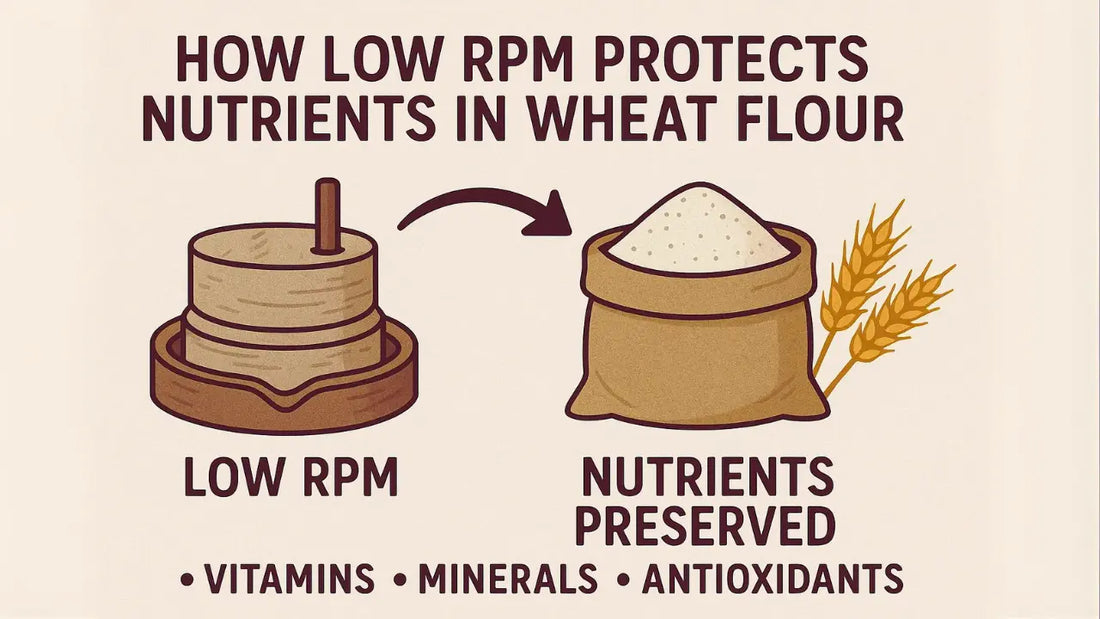
How Low RPM Protects Nutrients in Wheat Flour
MOORAV FOODTECH PRIVATE LIMITED AdminShare
When you buy flour for your home, you probably think about its freshness, texture, or taste. But there is another detail that greatly affects its quality and that is the speed at which it was milled. The speed of the milling process can make the difference between nutrient-rich flour and flour that has lost much of its natural goodness.
Low RPM milling is a traditional method that preserves the nutrients in wheat flour better than modern high-speed milling. It’s slower, gentler, and keeps the flour closer to its natural state. In this article, we’ll explore why speed matters, how low RPM works, and why it should matter to you as a buyer!
Table of Contents
-
Why Milling Speed Matters
-
What Is Low RPM Milling?
-
How Low RPM Protects Nutrients in Wheat Flour
-
Benefits of Preserving Nutrients in Wheat Flour
- The Difference Between Low RPM and High RPM
-
Why Buyers Should Care
-
The 10on10 Foods Promise
- Frequently Asked Questions
Why Milling Speed Matters
In modern industrial milling, wheat grains are ground at very high speeds. While this is efficient and produces large quantities quickly, it also generates heat. Excessive heat damages delicate vitamins, minerals, and oils in the grain. This means by the time the flour reaches your kitchen, many of the natural nutrients in wheat flour are already lost.
On the other hand, milling at a lower speed keeps the temperature down. This slower process ensures the nutritional value of the grain stays intact.
What Is Low RPM Milling?
Low RPM milling uses stone grinders or slow-moving metal plates to crush the grain gently. RPM means "revolutions per minute", which measures how fast the milling machine turns. In low RPM milling, the speed is kept deliberately slow, reducing friction and preventing heat build-up.
This method mimics the way flour was made centuries ago, slowly and naturally. While it may take longer, it results in flour that is more wholesome, tastier, and better for your health.
How Low RPM Protects Nutrients in Wheat Flour
Here’s why low RPM milling helps keep the goodness inside your flour:
1. Less Heat, More Nutrients
High-speed milling can heat flour to levels that break down vitamins such as B1 (thiamine), B3 (niacin), and E. Low RPM milling keeps the flour cool, preserving these vital nutrients in wheat flour.
2. Keeps Natural Oils Intact
Wheat germ contains healthy oils rich in vitamin E and antioxidants. These oils are sensitive to heat and can go rancid if overheated. Low RPM protects them, keeping your flour fresher for longer.
3. Maintains Enzyme Activity
Enzymes in wheat help your body digest and absorb nutrients better. Excess heat can deactivate these enzymes. Low RPM milling ensures they remain active in the final flour.
4. Preserves Fibre and Protein Quality
Low-speed milling keeps the bran and germ structure intact. This means the fibre stays effective for digestion and the protein retains its natural quality.
Benefits of Preserving Nutrients in Wheat Flour
When your flour keeps its natural nutrients, it directly benefits your health and your meals:
-
Better digestion from fibre that is still active and effective.
-
Steadier energy levels thanks to complex carbohydrates and natural protein.
-
Richer taste and aroma from preserved oils and minerals.
-
Improved immunity from vitamins and antioxidants.
-
Fresher flour that lasts longer without artificial preservatives.
These benefits are only possible if the milling process is gentle enough to protect the original nutrients in wheat flour.
The Difference Between Low RPM and High RPM
|
Feature |
Low RPM Grinding |
High RPM Grinding |
|
Speed |
Slow |
Very fast |
|
Heat generation |
Very low |
High |
|
Nutrient retention |
High |
Low |
|
Shelf life |
Longer |
Shorter |
|
Taste |
Natural and fresh |
Less flavourful |
Why Buyers Should Care
Choosing flour is more than just picking a brand from the shelf. If you care about your family’s health, the milling process matters as much as the grain quality.
Low RPM milling may cost a little more and take longer, but it delivers flour that is closer to what nature intended. This means you are not just feeding your family—you are nourishing them.
The 10on10 Foods Promise
At 10on10 Foods, we understand the value of protecting the natural goodness in every grain. That’s why our wheat flour is milled using low RPM techniques. We source only high-quality wheat from trusted farmers, and we mill it in small batches to keep the nutrients in wheat flour intact.
No chemicals. No bleaching. No shortcuts. Just clean, wholesome flour you can trust.
Order your pack of 10on10 Foods Wheat Flour today and enjoy the difference that low RPM milling makes.
Frequently Asked Questions Low RPM Protects Nutrients in Wheat Flour
Q1. Does low RPM milling make flour more expensive?
A1. It can cost slightly more because it takes longer and produces smaller batches. But the health benefits from preserved nutrients make it worth it.
Q2. Can I use low RPM milled flour for all recipes?
A2. Yes. You can use it for chapatis, breads, cakes, and biscuits. You might notice a richer flavour and slightly denser texture in baked goods.
Q3. How long does low RPM milled flour stay fresh?
A3. Because the natural oils are preserved, the flour can last several weeks if stored in a cool, dry place. For longer storage, refrigerate or freeze it.
Q4. Why is low RPM flour darker in colour?
A4. The darker colour comes from the bran and germ, which are kept intact. This is a sign that the flour is less processed and contains more natural nutrients.

